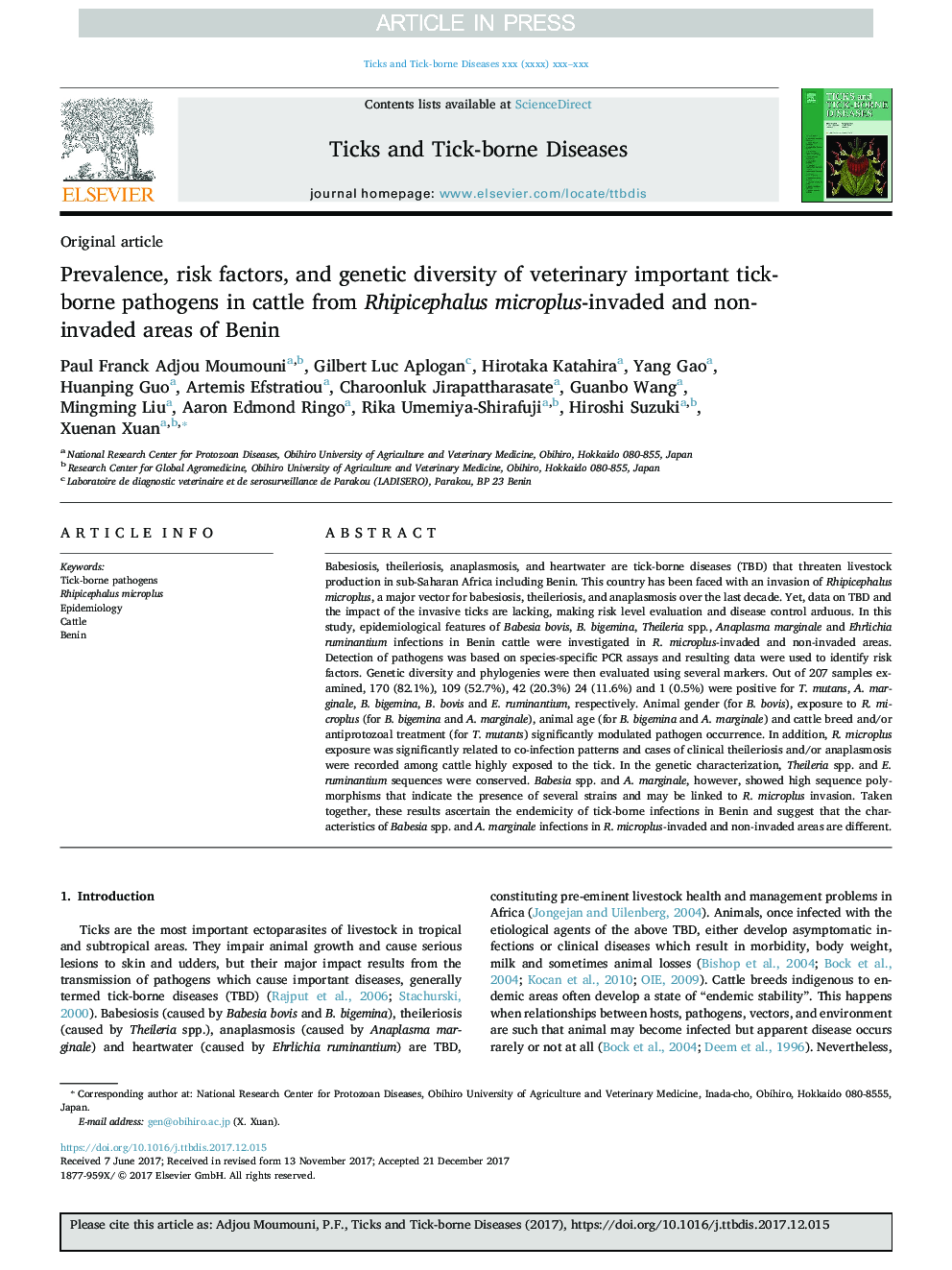| کد مقاله | کد نشریه | سال انتشار | مقاله انگلیسی | نسخه تمام متن |
|---|---|---|---|---|
| 8507155 | 1555961 | 2018 | 15 صفحه PDF | دانلود رایگان |
عنوان انگلیسی مقاله ISI
Prevalence, risk factors, and genetic diversity of veterinary important tick-borne pathogens in cattle from Rhipicephalus microplus-invaded and non-invaded areas of Benin
دانلود مقاله + سفارش ترجمه
دانلود مقاله ISI انگلیسی
رایگان برای ایرانیان
کلمات کلیدی
موضوعات مرتبط
علوم زیستی و بیوفناوری
علوم کشاورزی و بیولوژیک
علوم دامی و جانورشناسی
پیش نمایش صفحه اول مقاله

چکیده انگلیسی
Babesiosis, theileriosis, anaplasmosis, and heartwater are tick-borne diseases (TBD) that threaten livestock production in sub-Saharan Africa including Benin. This country has been faced with an invasion of Rhipicephalus microplus, a major vector for babesiosis, theileriosis, and anaplasmosis over the last decade. Yet, data on TBD and the impact of the invasive ticks are lacking, making risk level evaluation and disease control arduous. In this study, epidemiological features of Babesia bovis, B. bigemina, Theileria spp., Anaplasma marginale and Ehrlichia ruminantium infections in Benin cattle were investigated in R. microplus-invaded and non-invaded areas. Detection of pathogens was based on species-specific PCR assays and resulting data were used to identify risk factors. Genetic diversity and phylogenies were then evaluated using several markers. Out of 207 samples examined, 170 (82.1%), 109 (52.7%), 42 (20.3%) 24 (11.6%) and 1 (0.5%) were positive for T. mutans, A. marginale, B. bigemina, B. bovis and E. ruminantium, respectively. Animal gender (for B. bovis), exposure to R. microplus (for B. bigemina and A. marginale), animal age (for B. bigemina and A. marginale) and cattle breed and/or antiprotozoal treatment (for T. mutants) significantly modulated pathogen occurrence. In addition, R. microplus exposure was significantly related to co-infection patterns and cases of clinical theileriosis and/or anaplasmosis were recorded among cattle highly exposed to the tick. In the genetic characterization, Theileria spp. and E. ruminantium sequences were conserved. Babesia spp. and A. marginale, however, showed high sequence polymorphisms that indicate the presence of several strains and may be linked to R. microplus invasion. Taken together, these results ascertain the endemicity of tick-borne infections in Benin and suggest that the characteristics of Babesia spp. and A. marginale infections in R. microplus-invaded and non-invaded areas are different.
ناشر
Database: Elsevier - ScienceDirect (ساینس دایرکت)
Journal: Ticks and Tick-borne Diseases - Volume 9, Issue 3, March 2018, Pages 450-464
Journal: Ticks and Tick-borne Diseases - Volume 9, Issue 3, March 2018, Pages 450-464
نویسندگان
Paul Franck Adjou Moumouni, Gilbert Luc Aplogan, Hirotaka Katahira, Yang Gao, Huanping Guo, Artemis Efstratiou, Charoonluk Jirapattharasate, Guanbo Wang, Mingming Liu, Aaron Edmond Ringo, Rika Umemiya-Shirafuji, Hiroshi Suzuki, Xuenan Xuan,